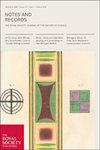分类、观察实践与亨利·西博姆的《维多利亚晚期英国日本帝国的鸟类》
IF 0.6
3区 哲学
Q3 HISTORY & PHILOSOPHY OF SCIENCE
Notes and Records-The Royal Society Journal of the History of Science
Pub Date : 2023-10-18
DOI:10.1098/rsnr.2023.0059
引用次数: 0
摘要
1890年下半年,鸟类学家亨利·西博姆(Henry Seebohm, 1832-1895)出版了他的著作《日本帝国的鸟类》,在全世界都很受欢迎。然而,尽管他去过希腊、南非和西伯利亚等地,但他从未去过日本。相反,他的日本鸟类知识是通过建立知识和网络、标本获取和比较以及采用新的分类系统等二手方法收集的。作为一个“扶手椅”从业者,Seebohm的这些观察方法有助于提高他作为日本鸟类权威的声誉。尽管围绕20世纪日本帝国鸟类学专业化的兴起,学术界的研究有所增加,但很少有人注意到维多利亚时代的各种博物学家,他们是19世纪鸟类学起源的核心。因此,本文的目的是通过关注sebohm在1878年至1890年之间的活跃岁月来记录这样一位博物学家的重要性。通过这一分析,我认为Seebohm的观察实践,特别是他对新颖的三种分类的使用,是确保他对日本鸟类的可信度的核心,尽管他从未访问过日本,因此他1890年的书成为日本帝国鸟类学发展的里程碑。本文章由计算机程序翻译,如有差异,请以英文原文为准。
Classification, Observational Practice, and Henry Seebohm’s The Birds of the Japanese Empire in Late-Victorian Britain
In the latter months of 1890 the ornithologist Henry Seebohm (1832–1895) published his transnationally well-received The birds of the Japanese Empire . However, although travelling widely to places such as Greece, South Africa and Siberia, Seebohm never visited Japan. Instead, his knowledge of Japanese birds was gathered through second-hand methods including knowledge and network building, specimen acquiring and comparing and the adoption of a novel classification system. These observational methods of Seebohm as an ‘armchair’ practitioner served to enhance his name as an authority on Japanese birds. Despite an increase in scholarship surrounding the emergence of professionalized twentieth-century Japanese imperial ornithology, little attention has been paid to the various Victorian naturalists who were central to its nineteenth-century origins. Therefore, the aim of this paper is to document the importance of one such naturalist by focusing on Seebohm’s active years between 1878 and 1890. Through this analysis I argue that Seebohm’s observational practices, particularly his use of a novel trinomial classification, were central to securing his credibility on Japanese birds despite never visiting Japan, and that consequently his 1890 book became a landmark in the development of ornithology in the Japanese Empire.
求助全文
通过发布文献求助,成功后即可免费获取论文全文。
去求助
来源期刊
CiteScore
1.50
自引率
0.00%
发文量
45
审稿时长
>12 weeks
期刊介绍:
Notes and Records is an international journal which publishes original research in the history of science, technology and medicine.
In addition to publishing peer-reviewed research articles in all areas of the history of science, technology and medicine, Notes and Records welcomes other forms of contribution including: research notes elucidating recent archival discoveries (in the collections of the Royal Society and elsewhere); news of research projects and online and other resources of interest to historians; essay reviews, on material relating primarily to the history of the Royal Society; and recollections or autobiographical accounts written by Fellows and others recording important moments in science from the recent past.

 求助内容:
求助内容: 应助结果提醒方式:
应助结果提醒方式:


